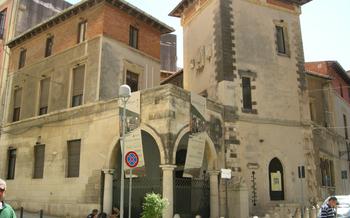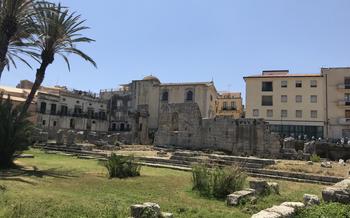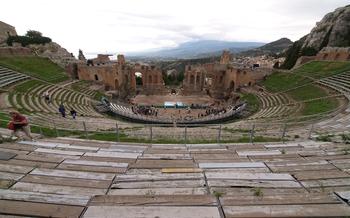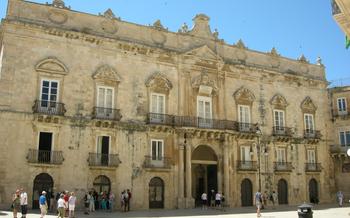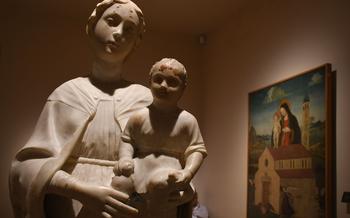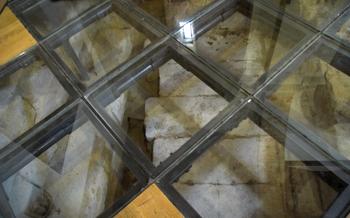
Greek Theatre of Syracuse
- Syracuse: A Place of Ancient Wonders
- History of the Greek Theatre
- Acoustics of the Theatre
- Cavea (Seating Area)
- Orchestra and Stage
- Behind-the-Scenes Exploration
- Greek Theatre Performances Today
- Exploring the Surroundings
- Virtual Reality Experience: Unveiling Ancient Syracuse Through Technology
- The Greek Theatre's Impact on Modern Architecture
- Restoration and Conservation Efforts
- Visiting the Theatre
- Accommodation and Dining
- A Walk Through History
- Insider Tip - Photographic Opportunities
Syracuse: A Place of Ancient Wonders
Syracuse, a city steeped in history and legend, boasts an impressive collection of ancient ruins that transport visitors back to the vibrant days of Greek and Roman civilization. Among these, the Greek Theatre of Syracuse stands out as a remarkable testament to the city's glorious past. Nestled within the archaeological park of Neapolis, just a short walk from the city center, this ancient theatre is waiting to unveil its secrets and captivate your imagination.
History of the Greek Theatre
The Greek Theatre of Syracuse stands as a testament to the ingenuity and artistry of the ancient Greeks. Built in the 5th century BC, it boasts a remarkable design that has withstood the passage of time. Its massive structure, carved into the hillside, features a vast cavea (seating area) capable of accommodating over 15,000 spectators. The theatre's impressive acoustics, achieved through its unique architectural features, have made it a marvel of ancient engineering.
The theatre's construction showcases the Greeks' mastery of building techniques. Constructed primarily from limestone, it features intricate carvings and decorative elements that adorn its facade. The stage, ornately decorated with sculptures and reliefs, served as a backdrop for theatrical performances and musical events. The orchestra, a circular area in front of the stage, provided space for the chorus to perform.
The Greek Theatre was a hub of entertainment and cultural expression in ancient Syracuse. It hosted a variety of spectacles, including tragedies, comedies, and musical performances. The theatre's acoustics allowed the actors' voices to be heard clearly throughout the vast auditorium, creating an immersive experience for the audience. The performances often incorporated elaborate costumes, masks, and stage props, enhancing the theatrical experience.
In addition to its entertainment function, the theatre served as a venue for public assemblies and civic events. The Greeks' love of democracy and civic engagement was reflected in the use of the theatre as a platform for political debates, speeches, and community gatherings.
The endurance of the Greek Theatre is a testament to the enduring legacy of ancient Greek culture. Over the centuries, it has undergone restoration efforts and modifications, but its fundamental structure and design have remained largely intact. Today, it stands as a symbol of Syracuse's rich history and cultural heritage, inviting visitors to step back in time and experience the grandeur of ancient Greek theatre.
Acoustics of the Theatre
The ancient Greeks were masters of acoustics, and the Greek Theatre of Syracuse is a testament to their skill. The theatre's design creates near-perfect acoustics, allowing the voices of actors to be heard clearly even in the farthest rows. This was achieved through a combination of factors, including the shape of the cavea, the materials used in its construction, and the careful placement of the stage.
Modern experiments have confirmed the exceptional acoustics of the theatre. In one experiment, a single speaker standing in the center of the stage was able to be heard clearly by listeners in every seat of the cavea. This is a remarkable feat, considering that the theatre can hold over 15,000 spectators.
One of the most striking features of the theatre's acoustics is the whispering gallery. This is a small chamber located beneath the stage, which creates a unique echo effect. If you stand in the whispering gallery and whisper against the wall, your voice can be heard clearly by someone standing on the opposite side of the chamber, even though they are over 50 meters away. This phenomenon is due to the way sound waves bounce off the walls of the chamber and are amplified.
The acoustics of the Greek Theatre of Syracuse are a marvel of ancient engineering. They allowed the theatre to be used for a variety of performances, including plays, concerts, and political speeches. The theatre's exceptional acoustics also made it a popular venue for religious ceremonies and festivals.
Cavea (Seating Area)
The cavea, or seating area, of the Greek Theatre of Syracuse is a marvel of ancient engineering. Its layout comprises 67 tiers of seats arranged in seven wedge-shaped sectors, separated by staircases for easy access. The lower tiers, known as the ima cavea, were reserved for the wealthy and prominent citizens, while the upper tiers, or summa cavea, were designated for ordinary spectators.
The theatre's impressive capacity of over 15,000 spectators speaks to its significance as a cultural and civic center in ancient Syracuse. The seating rows are meticulously carved into the hillside, ensuring excellent sightlines and acoustics for every attendee. The cavea's vast expanse creates a sense of grandeur and immersion, transporting visitors back to the days when this theatre was buzzing with life and spectacle.
During performances, the audience would have been treated to a breathtaking panorama of the surrounding landscape. With the Mediterranean Sea as a backdrop, the theatre offered a scenic setting that further enhanced the theatrical experience. The combination of the stunning natural scenery and the architectural splendor of the theatre created an unforgettable ambiance for the ancient spectators.
Orchestra and Stage
The orchestra, situated in front of the stage, played a crucial role in ancient Greek theatre. This circular area, known as the orchestra, served as a performance space for the chorus, whose members sang, danced, and interacted with the actors on stage. The orchestra's primary function was to provide a dynamic and engaging space for choral performances, enhancing the overall theatrical experience.
The orchestra in the Greek Theatre of Syracuse is remarkable for its innovative draining system, which allowed for effective water management. Ancient engineers designed a sophisticated network of channels and pipes beneath the orchestra to prevent flooding and ensure that rainwater was efficiently drained away. This intricate system not only ensured the functionality of the theatre during inclement weather but also showcased the remarkable engineering skills of the ancient Greeks.
The stage, positioned at the far end of the orchestra, was an essential element of the ancient theatre. Elaborate stage decorations and background scenes were used to create immersive settings for various performances. These intricate backdrops, known as skene, added depth and realism to the theatrical productions, transporting audiences to different worlds and enhancing the emotional impact of the plays.
Behind-the-Scenes Exploration
Venture beyond the visible stage of the Greek Theatre of Syracuse and discover a hidden world beneath your feet. Explore the intricate network of underground tunnels that once allowed actors and stagehands to move swiftly and unseen, creating a sense of awe and mystery for the audience. These tunnels, remarkably well-preserved despite the passage of time, offer a glimpse into the behind-the-scenes workings of this ancient masterpiece.
Imagine the actors preparing for their performances, donning elaborate costumes and rehearsing their lines in these subterranean chambers. Discover storage areas where props and costumes were meticulously organized, ensuring smooth transitions during performances. Imagine the daily life of ancient performers, their excitement and camaraderie as they prepared to bring unforgettable stories to life on stage.
Greek Theatre Performances Today
The ancient Greek Theatre of Syracuse has transcended time and continues to serve as a vibrant cultural venue. While its original purpose was to host theatrical performances, the theatre has adapted to modern times and now offers a diverse range of events.
Today, the theatre hosts a variety of performances, including classical Greek dramas, contemporary plays, concerts, and dance recitals. These performances showcase the versatility of the theatre and its ability to accommodate different artistic expressions.
To attend a modern performance at the Greek Theatre of Syracuse, visitors can check the theatre's official website or consult local tourism offices for the schedule and ticket information. The theatre also hosts regular theatre festivals, such as the Siracusa Teatro Greco Festival, which attracts theatre enthusiasts from around the world.
Attending a performance at the Greek Theatre of Syracuse is an unforgettable experience. The combination of the ancient setting, the acoustics, and the high-quality performances creates a magical atmosphere that transports audiences back in time to the era of ancient Greece.
Exploring the Surroundings
Beyond the confines of the Greek Theatre, the archaeological park of Neapolis offers a captivating journey through ancient history, uncovering the remnants of a glorious past. Explore the nearby ruins of the Roman amphitheater, once the stage for gladiatorial contests and public spectacles. Discover the Latomie del Paradiso, a former limestone quarry transformed into a tranquil garden, where nature harmoniously intertwines with ancient history. Admire the Altar of Hieron II, a monumental structure that once stood in the heart of the ancient city.
Immerse yourself in the Neapolis Museum, a treasure trove of artifacts excavated from the Greek Theatre and the surrounding area. Gaze upon intricate sculptures, ceramics, and inscriptions that narrate the captivating tales of Syracuse's past. Stroll through the lush gardens adjacent to the theatre, where vibrant flora and tranquil walkways provide a serene respite from the bustling city.
Virtual Reality Experience: Unveiling Ancient Syracuse Through Technology
Enhance your visit to the Greek Theatre of Syracuse with a cutting-edge virtual reality experience. Through interactive tours, immerse yourself in the grandeur of ancient Syracuse, virtually strolling through the bustling streets and marveting at iconic landmarks. Don a VR headset and step back in time, experiencing the theatre as it once was, filled with vibrant crowds and resounding with the echoes of ancient performances.
Engage with interactive storytelling elements that bring to life the theatre's rich history. Learn about the actors, musicians, and playwrights who graced its stage, and discover the cultural significance of the plays that were performed here. Through virtual reality, you can explore the theatre's intricate architectural details, marvel at its acoustics, and gain a deeper understanding of its role in ancient Greek society.
This immersive experience is not just a technological novelty; it's a journey into the past that allows you to connect with the essence of the Greek Theatre of Syracuse in a way that was never before possible. Embrace the power of virtual reality to unlock the secrets of this ancient wonder and create lasting memories of your visit.
The Greek Theatre's Impact on Modern Architecture
The Greek Theatre of Syracuse has not only been a witness to ancient performances but has also left a profound impact on modern architecture. During the Renaissance, there was a resurgence of interest in classical art and architecture, and the theatre served as a source of inspiration for architects and artists.
The Italian architect Andrea Palladio was particularly captivated by the theatre's design. He visited Syracuse and studied the theatre extensively, incorporating its principles into his own architectural designs. The most notable example of Palladio's debt to the Greek Theatre is the Teatro Olimpico in Vicenza, Italy, which features a similar layout, stage design, and use of perspective.
The Teatro Olimpico, built in the late 16th century, is considered one of the earliest examples of modern theatre architecture. Its design, directly inspired by the Greek Theatre, set the stage for the development of modern theatre design principles. Palladio's innovative use of perspective created the illusion of depth and grandeur, making the theatre an immersive and awe-inspiring experience for audiences.
The influence of the Greek Theatre can also be seen in other modern theatres around the world. The horseshoe-shaped layout, the tiered seating, and the use of elaborate stage decorations have become standard features in modern theatre design. The Greek Theatre's legacy continues to live on, inspiring architects and designers to create spaces that evoke the grandeur and spectacle of ancient Greek performances.
Restoration and Conservation Efforts
The Greek Theatre of Syracuse has undergone numerous restoration and conservation efforts throughout its long history. These initiatives aim to preserve the theatre's historical integrity while ensuring its accessibility and safety for visitors.
In the 18th century, excavations led by the Spanish architect and engineer, Emanuele Vanvitelli, revealed the theatre's significant remains. These discoveries sparked interest in the theatre's restoration, resulting in the removal of debris and the reinforcement of existing structures.
In 1897, the Italian architect, Paolo Orsi, conducted comprehensive excavations that uncovered more sections of the theatre, including the stage and the orchestra. Orsi's work provided valuable insights into the theatre's original design and layout, contributing to the development of a comprehensive restoration plan.
In the 20th century, major restoration projects were undertaken to address structural issues and enhance the theatre's appearance. These projects involved the consolidation of stonework, the reconstruction of collapsed elements, and the installation of drainage systems to prevent water damage.
Presently, the theatre is under the supervision of the Archaeological Park of Syracuse, which is responsible for ongoing conservation and maintenance efforts. The park's mission is to protect and preserve the theatre for future generations while ensuring that it remains accessible to visitors from around the world.
Visiting the Theatre
Practical Information: The Greek Theatre of Syracuse is open to the public daily from 8 am to 8 pm. Admission fees vary depending on the season and any special events or exhibitions. The site is wheelchair accessible, with ramps and designated areas for visitors with disabilities.
Guided Tours: Enrich your visit by booking a guided tour. Knowledgeable guides provide insightful commentary on the theatre's history, architecture, and acoustics. Tours are available in various languages and can be arranged through the Archaeological Park's visitor center.
Self-Guided Exploration: For a more intimate experience, explore the theatre independently. Information panels and maps are provided to help visitors navigate the site. Take your time to wander through the cavea, orchestra, and stage, imagining the vibrant atmosphere of ancient performances.
Accommodation and Dining
When planning your visit to the Greek Theatre of Syracuse, you'll have a variety of accommodation options to choose from. Numerous hotels, bed and breakfasts, and guesthouses are located within walking distance of the theatre, offering a range of amenities and price points to suit every traveler.
For a truly immersive experience, consider staying in the historic center of Syracuse, known as Ortygia. This enchanting island neighborhood is a treasure trove of ancient ruins, charming streets, and lively piazzas. Several hotels and guesthouses here offer panoramic views of the Mediterranean Sea and are just a short stroll from the theatre.
No visit to Syracuse is complete without indulging in the delectable local cuisine. The city is renowned for its fresh seafood, pasta dishes, and sweets. Treat your taste buds to traditional Sicilian specialties such as arancini (rice balls stuffed with meat or cheese), pasta alla Norma (pasta with eggplant, tomatoes, and ricotta salata), and cannoli (tube-shaped pastries filled with sweet ricotta).
For a memorable dining experience, head to one of the many restaurants and cafes nestled near the theatre. Enjoy a leisurely meal al fresco, surrounded by the evocative atmosphere of ancient ruins. Savor the flavors of Sicily while immersing yourself in the city's rich history.
A Walk Through History
As you wander through the ancient ruins of the Greek Theatre of Syracuse, let your imagination take flight. Picture the bustling crowds of spectators filling the cavea, eager to witness the latest theatrical performances. Imagine the actors strutting across the stage, their voices reverberating through the exceptional acoustics.
Feel the tangible connection to the past as you walk in the footsteps of ancient Greeks. This theatre was not merely a place of entertainment; it was a hub of cultural exchange, intellectual discourse, and artistic expression. Within these timeworn stones, the stories of ancient Greek mythology, history, and philosophy came to life.
Embrace the awe and wonder that inevitably accompanies a visit to this ancient space. The theatre's grandeur, its resilience against the ravages of time, and its enduring legacy as a symbol of Greek culture will leave you filled with a profound sense of reverence.
Insider Tip - Photographic Opportunities
Capture the true essence of the Greek Theatre of Syracuse through photography. Aim to visit during the golden hour, just before sunset, when the warm light casts a magical glow on the ancient stones. Experiment with different angles, venturing beyond the traditional frontal shots to discover hidden corners and unique perspectives. Photograph the theatre in isolation, showcasing its grandeur against the clear blue sky, and also capture it in harmony with the surrounding landscape, including the lush greenery and distant cityscape. Your photographs will not only serve as beautiful mementos of your visit but will also convey the theatre's timeless allure and historical significance.
